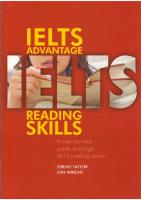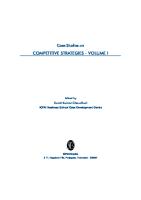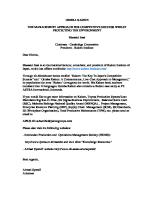McDonald's Competitive Advantage [PDF]
Running head: McDonald’s Sustainable Competitive Advantage 1 McDonald’s Sustainable Competitive Advantage [Institution
38 0 83KB
Papiere empfehlen
![McDonald's Competitive Advantage [PDF]](https://vdoc.tips/img/200x200/mcdonaldx27s-competitive-advantage.jpg)
- Author / Uploaded
- Sam Uduma
Datei wird geladen, bitte warten...
Zitiervorschau
Running head: McDonald’s Sustainable Competitive Advantage 1
McDonald’s Sustainable Competitive Advantage
[Institutional Affiliation(s)]
Author Note [Include any grant/funding information and a complete correspondence address.]
MCDONALD’S SUSTAINABLE COMPETITIVE ADVANTAGE 2 McDonald’s Sustainable Competitive Advantage The fast-food industry is extremely competitive. However, to be relevant in the fast-food market, a firm must stand out and portray a competitive edge over its rivals. There are quite a handful of small fast-food businesses in the western world that compete against each other to garner a bigger customer base. McDonald is one of them and a giant at that too. Since its inception in 1940, it has continuously served a worldwide chain of 30,000 restaurants. Recently, there has been a greater expansion in the number of fast-food companies operating and jostling for customer attention (Panwar & Patra, 2017). McDonald’s, being one of these fast-food chains has developed strategies that help expand its products and services in many countries. The major competitive advantage that McDonald’s have is its franchise business model (Mourdoukoutas, 2015), which allows it to retain the control and ownership of its entire value chain that ranges from farming, product development, distribution, branding and marketing, sales, real estate, and restaurant experience. Additionally, the franchise business model brought about strong brand recognition and geographic spread across the globe creating a key competitive advantage that makes McDonald’s a giant in the fast-food business, and also boasting an omnipresent and a universal high awareness brand. This global appeal is making people who recognize the golden arches to trust the brand to deliver highly appealing food of good quality and taste. Consequently, the global appeal has made McDonald’s transform its franchising into a science, such that, it garners the most patronage and maximizes sales by localizing its franchises and covering the costs of the set-up. McDonald’s has over the years to its advantage, mastered the copyrighted system within the kitchens, that they have fine-tuned to the detail. Planning is key at every McDonald’s kitchen, evidenced in its daily schedule for everything down to the
MCDONALD’S SUSTAINABLE COMPETITIVE ADVANTAGE 3 individual minute – which ranges from opening time to when to start serving fries and so on. This boils down to having a perfect understanding of who its customers are and what they want. McDonald’s smart and prudent goals of establishing a fast-food restaurant in every corner through aggressive franchising determine its competitive advantage in the fast-food business (Amor, 2013). This strong strategy that leverages its key strengths allows McDonald’s to attain economies of scale through operational efficiencies and creating an environment where it has continuously achieved its crucial targets and robust business processes. Value creation is perceived by consumers to be borne out of an individual’s needs based on an appraisal or judgment of various facets of a firm. The value of the brand that McDonald’s provide is determined and driven by customers’ perceptions and by pre-existing actions that it takes to create strategies, resource allocations, and a marketing mix that supports its benefits (Harrington et al, 2017). The major objective which McDonald’s has achieved is a lasting universal consumer satisfaction that earned their loyalty by offering new and improved on pre-existing brand value. This key strategy has been responsible for the growth, performance, and long-term viability which McDonald’s is globally known for (Landroquez et al., 2013). McDonald’s has utilized value creation and value appropriation as a key competitive advantage to strengthen and improve consumers’ valuation of rewards they received while consuming its products.
MCDONALD’S SUSTAINABLE COMPETITIVE ADVANTAGE 4 References Amor A. (2013). McDonald’s Competitive Strategy, Munich, GRIN Verlag, https://www.grin.com/document/269111 Harrington, R. J., Ottenbacher, M. C., & Fauser, S. (2017). QSR brand value. International Journal of Contemporary Hospitality Management. Harrington, R.J., Way, K., and Ottenbacher, M.C. (2013), “Quick service restaurant attributes: the impact on restaurant consumers’ selection decision”, Journal of Quality Assurance in Hospitality and Tourism, Vol. 14 No. 1, pp. 81-100. Landroquez, S.M., Castro, C.B. and Cepeda-Carrión, G. (2013), “Developing an integrated vision of customer value”, Journal of Services Marketing, Vol. 27 No. 3, pp. 234-244. Mourdoukoutas, P. (2015, July 17). McDonald's most important advantage. Forbes. https://www.forbes.com/sites/panosmourdoukoutas/2015/01/29/mcdonalds-mostimportant-advantage/#59c7519d5c41 Panwar, D., & Patra, S. (2017). Localization in the Fast Food industry: A case study on McDonald’s strategy in India. Journal of Arts, Science & Commerce, 8(1), 70-74.









